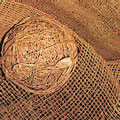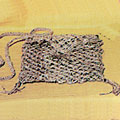Fibres from the Himalayan giant nettle (Girardinia diversifolia), locally known as allo, have been extracted for use in Nepal for hundreds of years – this extraction and use continues till today. Because of its size the allo plant is also referred to as hati sisnu, or elephant nettle. The bark fibre has been extracted, spun and woven for centuries by the Magars, Tamangs, Gurungs, the nomadic Rautye, and especially the Rais. This most unusual of form of textile has been used for ropes, sacks, bags, head bands, mats, fishing nets, and clothing for as long as anyone can remember.
TRADITIONS
This allo plant has, for long, provided the raw material for making a large proportion of the textiles needed by the household, including clothing, mats, sacks, bags, fishing-nets, ropes, carry, and head bands. All the weaving, including that of clothing, mats, sacks, and bags, is traditionally the preserve of the women, while fishing nets, ropes, and head bands are made by the men. In the past, allo textiles were bartered for grain in times of food shortage. Allo fishing-nets, porters’ headbands, sacks, bags, and mats are still in demand and in regular use.

RAW MATERIAL
The allo (Girardinia diversifolia) plant grows in most northern parts of Nepal and is also found in the hills from the west to the east of the country at altitudes ranging between 1,200m and 3,000 m. It flourishes under the shade of deciduous forests, and in moist, sandy soils, especially ravines; it can also be found on shrub land and on the edges of cultivated land, where it is used to consolidate bunds on terraced land. Growing to a height of 3 m, the thorn-covered stem, which contains the fibres, can measure up to 4 cm in diameter at the base. The plant has long, white thorns that have a very nasty sting, the effect of which lasts for about half-an-hour or so.
PROCESS & TECHNIQUE
Although there are variations in weaving techniques in different parts of Nepal, the basic methods of allo harvesting and spinning remain similar all over.
Harvesting begins towards the end of the monsoon season in August-September, and continues till March when the plants begin to flower. The villagers, both men and women, spend up to a week in the jungle collecting the bark. The best-quality fibre comes from the early harvests. Allo weavers believe that allo growing under shade yields the finest and whitest fibres, while plants that are more exposed to the sun are brownish in colour. Fibres from plants growing at high altitudes are the most valued for weaving.
Only mature, thick stems are harvested; others are left to seed. The stems are cut using sickles (hasias) at about 15 cm from the ground in order to leave sufficient stem for new shoots to sprout. The stinging thorns on both stems and leaves make the cutting of the stems hazardous and the harvesters protect their hands with bundles of cloth. Often, the stems are left for a few days before fibre extraction begins – this is done to reduce the potency of the stinging hairs. On an average, in one day, the bark of about 370 stems are harvested. The fresh bark of one allo stem can weigh up to 100 grams – it yields a maximum of 5 grams of dry fibre.
The bark is left to dry for a few weeks. The dried bark is then boiled with wood ash for about four to five hours to make it soft and to extract the fibre. Then it is washed with white mica clay soil (kamero mato) to lubricate the fibres and make their separation and spinning easier. Finally, the strands of fibre are hung-up and sun-dried. The surplus mica soil is dusted off before weaving,. During weaving – to prevent the allo yarn from getting fluffy – the weaver occasionally brushes the warp with water, using a shelled maize cob as a brush.

Traditionally, all allo cloth was woven on back-strap or body-tension looms, the women using a lightweight hand-spindle, about 40 cm long. Spindles and looms are standard equipment of every home. Weaving takes place mainly during winter when no fieldwork is done. With the minimum of simple components this type of loom fulfils the basic function of keeping the warp threads under tension while the weft thread is interwoven with them at right angles. All parts of the loom, except the wooden beater, are carved from bamboo at home. Though spinning by hand-spindle is slower than spinning on a wheel, the spindle has the advantage of weighing very little, being easily carried and used anywhere. Allo fibres are taken on most journeys and are spun not only when resting but even when walking. When the weaving is completed or at the end of the day, the loom parts can just be rolled together into a bundle, which is easily stored in the roof rafters.
INNOVATIONS
Traditional methods of spinning the yarn using a hand-spindle are still in use, though innovations in technique, materials, and equipment have resulted in giving this craft a big boost. Many changes have been introduced in the past few decades in processing, dyeing, weaving, and knitting. The adoption of a new type of allo cloth in which the traditional gimte pattern was woven with an allo warp and a wool weft, created a new market opportunity.
A warping-mill and two sturdy frame looms were adopted by some weavers, especially for heavy weight cloth and for creating a greater width than was available earlier. The twill and diamond patterned weave were also tried successfully with an allo warp. Twill allo cloth – and especially allo and wool tweed – found an immediate local market. Allo mats, based on traditional weaving and also cloth with cotton warp and allo weft, found a ready market among visitors and tourists.
New techniques of finishing have also been adopted by the weavers, The allo tweed cloth is first burled so that all knots and loose warp threads are mended, after which the cloth is washed and ‘wet’ finished by trampling with the feet in a thick soapy solution until it felts and shrinks to a prescribed measurement. It is then thoroughly rinsed and rolled onto a slatted drying roller.

PRODUCT RANGE
In recent years, traditional weaving of allo cloth has been on the increase. This warp-faced weave has a very firm texture which is needed for the jackets and waistcoats made from it – which offer protection against the cold – and for bags and sacks – which have to stand up to a lot of wear and tear.
The traditional allo jacket (phenga) of the Rais – with and without sleeves – is worn by men, women, and children. These jackets are beautifully embroidered with the embroidery serving the dual purpose of providing decoration as well as strengthening joints and seams.
Allo bags (jholas) in natural shades, from beige to brown, are valued for their strength and durability. The bag is carried over the head with the strap resting above the forehead, thus leaving both hands free.
Allo sacks are stronger and more durable than jute ones. Coming in sizes of about 58 cm X 108 cm, these sacks are usually made from a single piece.
Several products other than the traditional have been added on to the weavers’ repertoire – these include bags, wallets, place mats, and clothing and are popular with the tourist and export market. The weaving of these allo textiles have become a valuable source of supplementary income.
Gallery
YOUR VIEWS
PRACTITIONERS: INDIA
Access 70,000+ practitioners in 2500+ crafts across India.
BIBLIOGRAPHY
10,000+ listings on arts, crafts, design, heritage, culture etc.
GLOSSARY
Rich and often unfamiliar vocabulary of crafts and textiles.
SHOP at India InCH
Needs to be written.





